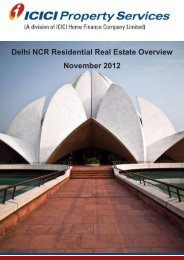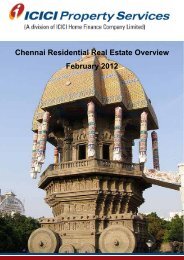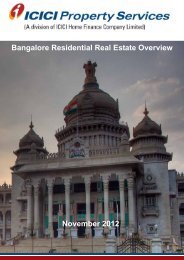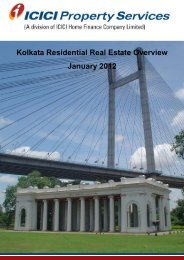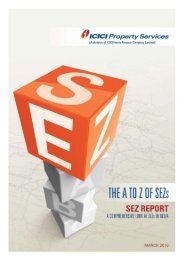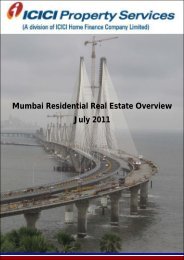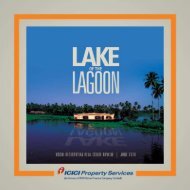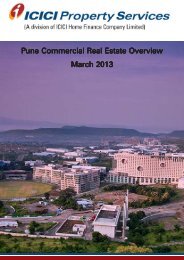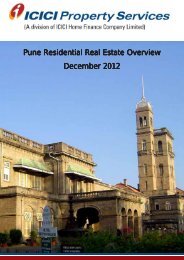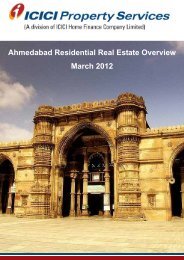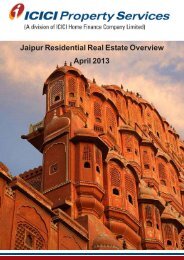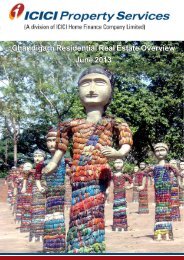Lucknow Residential Real Estate Overview July 2012 - ICICI Home ...
Lucknow Residential Real Estate Overview July 2012 - ICICI Home ...
Lucknow Residential Real Estate Overview July 2012 - ICICI Home ...
You also want an ePaper? Increase the reach of your titles
YUMPU automatically turns print PDFs into web optimized ePapers that Google loves.
EXECUTIVE SUMMARY<br />
The <strong>Lucknow</strong> <strong>Residential</strong> <strong>Real</strong> <strong>Estate</strong> <strong>Overview</strong>, <strong>July</strong> <strong>2012</strong>, offers a comprehensive insight into the key macro and<br />
micro trends evolving in the <strong>Lucknow</strong> residential realty markets. The <strong>ICICI</strong> <strong>Home</strong> Finance Company Research team<br />
undertook a detailed city survey and elucidated below are the key findings of the report.<br />
• On the basis of geographical location and development history, the report has broadly classified the city into two<br />
parts, Old <strong>Lucknow</strong> and New <strong>Lucknow</strong>. Old <strong>Lucknow</strong> was established during the 'Nawab' era and is typically<br />
dotted with old-cramped developments. However, New <strong>Lucknow</strong> which has emerged only a few decades ago, is<br />
replete with planned development and adequate social infrastructure. New <strong>Lucknow</strong> demonstrates high real<br />
estate potential and has been the focal point of our study.<br />
• <strong>Lucknow</strong> real estate market is currently a buyer's market and is largely driven by end users. Our estimates<br />
suggest 40% investor participation in New <strong>Lucknow</strong> and we anticipate some rise in these numbers in the future.<br />
• The market is primarily driven by bureaucrats, politicians, public/government servants, some private sector<br />
employees and original inhabitants of <strong>Lucknow</strong> who have now migrated outside, yet wish to have a base in<br />
<strong>Lucknow</strong>. Huge demand also flows in from surrounding cities on account of aspirations to enjoy better amenities<br />
and opportunities amiss in other cities of Uttar Pradesh.<br />
• <strong>Lucknow</strong> real estate markets have been stable with a slight upward bias. During the FY 2011-12 average price<br />
appreciation in certain locations has been in the range of 8 - 15%.<br />
• A recent CRISIL report titled '<strong>Real</strong>(i)ty Next-Beyond the top 10 cities of India’, stated that <strong>Lucknow</strong> is one of the<br />
next top ten cities with enormous real estate potential. The builders exude positive market sentiment in the long<br />
run, which is supported by the fact that many outside developers of repute have expressed interest in establishing<br />
their projects in the city.<br />
• The city's radial expansion has given way to new growth corridors on the real estate development map, especially<br />
along the highways that connect with neighboring cities such as Kanpur, Rae Bareli, Hardoi, Sitapur, Faizabad<br />
and Sultanpur. The real estate markets along these regions have recently witnessed some traction and many<br />
known developers have launched their projects along these locations. Moreover, focus on the supporting<br />
infrastructural development is also gaining ground.<br />
• While locations in Central <strong>Lucknow</strong> such as Mall Avenue and Jopling Road are old prime zones offering properties<br />
in the range of INR 3,500 - 6,500/sft., Gomtinagar and its extensions are new niche locations with properties in the<br />
price bracket of INR 2,000 - 4,000/sft. on offer. Many good projects by known developers spread across Gomtinagar,<br />
Rae Bareli Road, Sultanpur Road, Faizabad Road, Hardoi Road and Jankipuram have evoked a good response<br />
in the market.<br />
• The recent political change has brought a sense of optimism amongst market players. With the revival of LIDA<br />
(<strong>Lucknow</strong> Industrial Development Authority), there are plans to focus on Industrial and IT growth in the city. Such<br />
developments, once materialized, will provide the much needed impetus to the market demand.<br />
• <strong>Lucknow</strong> being the state capital, has emerged as a key center of business and financial activities for entire Uttar<br />
Pradesh. Government offices and BFSI sector are key segments which have witnessed growth in the city. Moreover,<br />
the Telecom sector has also emerged as a user of space in the city. MG Road (Mahatma Gandhi Road) at<br />
Hazratganj is the Central Business District (CBD) housing the main government and BFSI sector offices. Gomtinagar<br />
zone (esp. Vibhuti Khand and Vipin Khand) is emerging as a Secondary Business District (SBD). Faizabad Road,<br />
Mahanagar and Aliganj also witnessed some amount of commercial activity.<br />
• The organised retail market activity has paced-up in the city, especially in the last 4-5 years. While MG Road and<br />
Hazratganj are the most prominent shopping high-streets in <strong>Lucknow</strong>, Aminabad and Chowk are typical old retail<br />
destinations famous for 'Chikankari' works of small-scale industries. Moreover, Mahanagar, Indiranagar and<br />
Gomtinagar also have shopping arcades in various pockets. Organized retail is booming in the city and a number<br />
of malls (located in Hazratganj, Gomtinagar and Alambagh) have obtained a decent response. Sahara mall<br />
(Hazratganj), East End mall, Zee mall, Riverside mall (Gomtinagar) and Phoenix United mall (Alambagh) are<br />
operational malls witnessing decent foot-falls.<br />
3




